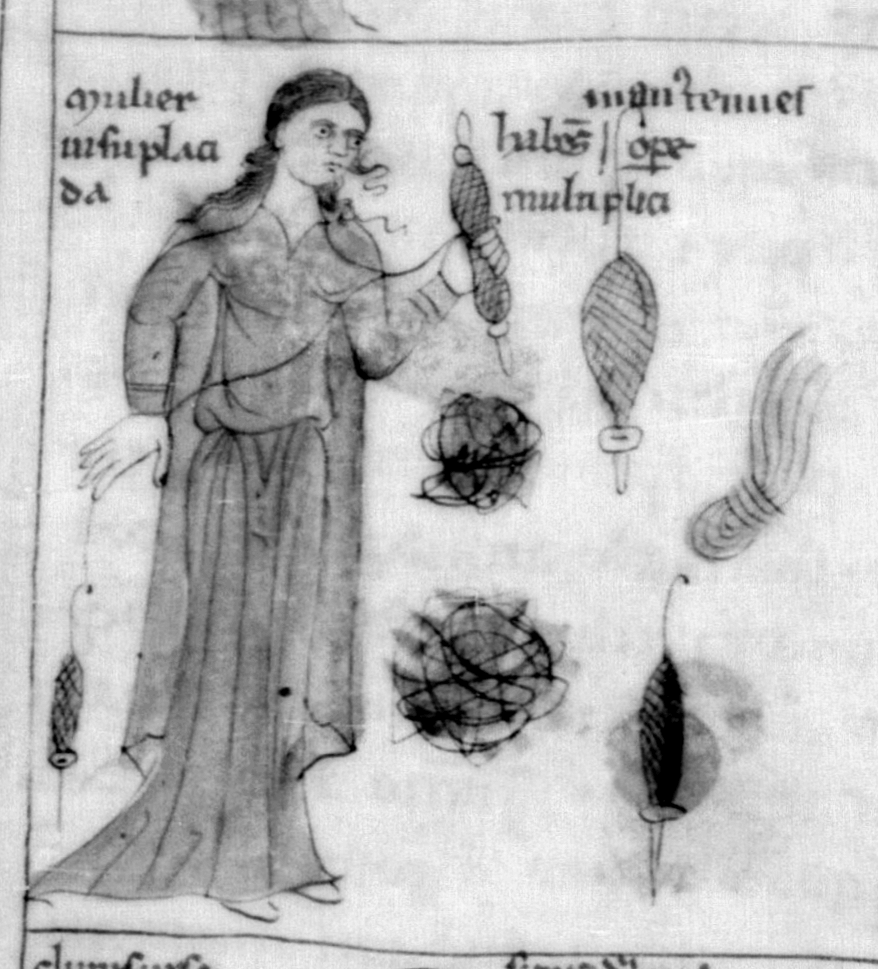Search the Blog
Latest Comments
A Rare Plying Picture.
I've come across one image recently, though - this one:
[caption id="attachment_5309" align="alignnone" width="390"]
 Bibliothèque Nationale de la France, Manuscript Latin 7330, liber astrologiae Georgii Zapari Zothori Fenduli, c 1301-1400. Fol. 30r, if I've interpreted things correctly. Permalink to the page in the digital BNF.
Bibliothèque Nationale de la France, Manuscript Latin 7330, liber astrologiae Georgii Zapari Zothori Fenduli, c 1301-1400. Fol. 30r, if I've interpreted things correctly. Permalink to the page in the digital BNF.That lady is not using a distaff, but instead she's holding two filled spindles in her left hand, and plies the threads together with the spindle hanging below her right hand.
Now that's definitely a rare picture, and a method I do have to try! Anyone here ever tried plying this way already? Or do you know more pictures like this? (Or, while I'm already blegging, images of spinners not in the classical one-arm-fully-extended position?)
Comments 7
I agree that this depicts plying, but I wonder in which direction she is working? If one looks at the string leading away from the long thing (or as you describe it, a pair of spindles) in her left hand, it looks like it separates into two strands at her shoulder, one of them heading across her body and down to the spindel in her right hand the other going up and over her shoulder and disappearing at her hair, or, possibly, heading down her back, out of sight. Since it is unlikely that she is trying to un-ply some yarn, if that really is a case of two threads merging into one, then I would read it as the artist showing the plying going to the long spindle in her right hand. However, in that case, the artist clearly doesn't know much about spinning, as the physics aren't working for me to have a thread coming over the shoulder, the other from the right hand, and then having them merge to coil onto the the spindle in the left hand.
Very interesting illustration. I've spindle plyed off 2 spindles before - one held in front and one behind sitting on a chair, it was a bit messy and quite difficult and time consuming especially with fine yarns to keep the yarn of the singles straight so it plyed nicely on the 3rd spindle. I learnt recently to ply on the fly using a Turkish spindle but this method would work with any bottom whorl spindle I think, with a few modifications. You make a temporary cop higher on the shaft then when you have about 3m of single wound on there you can chain ply it easily then wind onto the permanent cop. Remember to keep a loop on the spindle shaft as you make subsequent temporary cops so that you don't lose the end of your chain!
Thank you all for your comments! I've finally gotten around to try it, my first impressions are here: https://www.pallia.net/en/blog/2020/07/14/plying-off-two-spindles/



